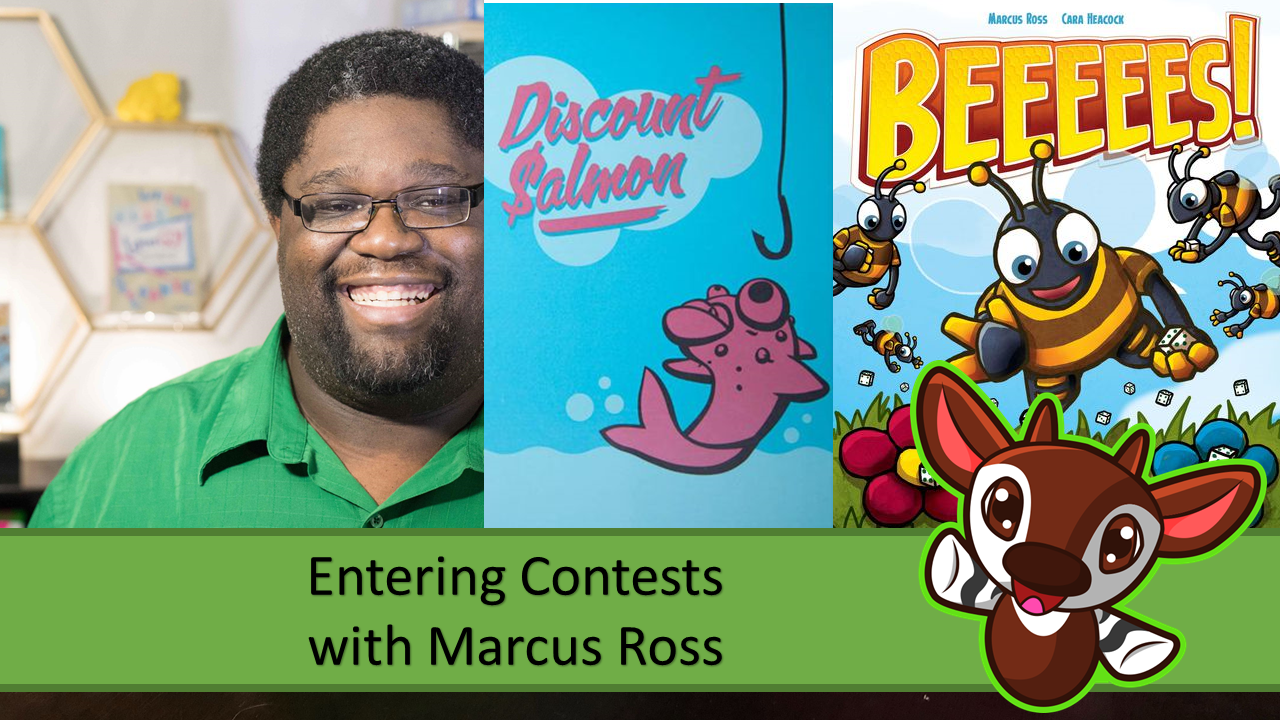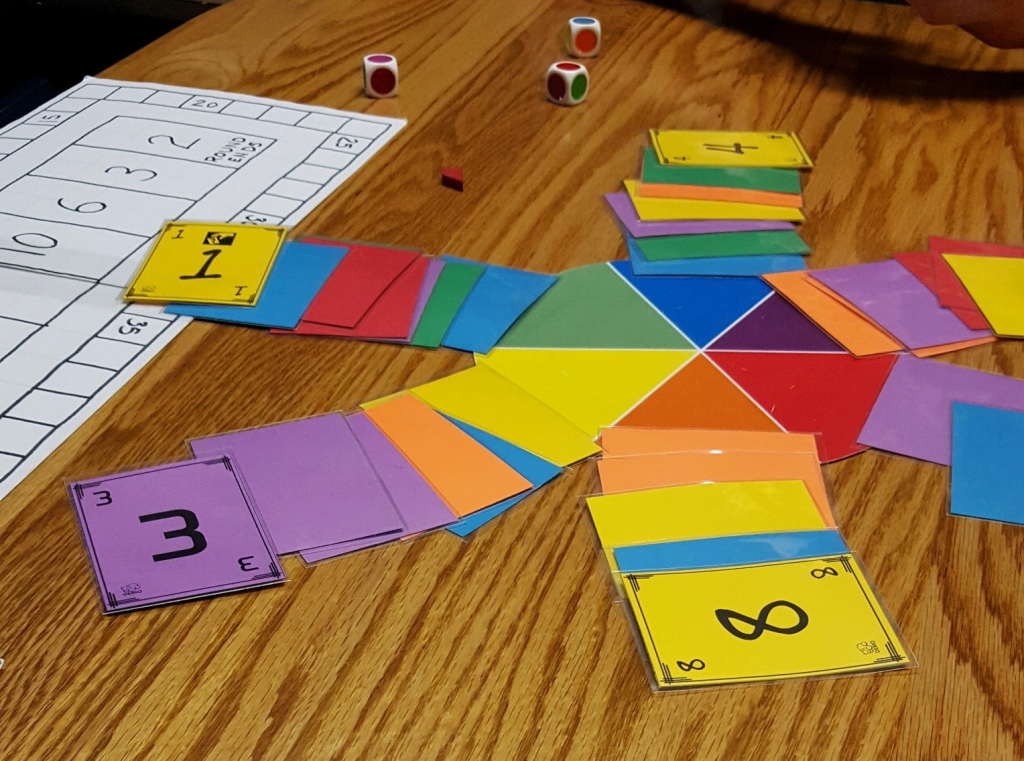
Marcus Ross goes in depth on how to enter and win contests and why you might want to do this as a game designer. Marcus Ross designed BEEEES, Discount Salmon, and more! He also runs Waterbear Games.
Watch the live chat below:
Discount Salmon, BEEEES, and Color Spiel were all designed by Marcus and won the contests they were entered in.

Discount Salmon was Marcus’ first design contest win. In the contest, you just had to have a game that wasn’t published yet and the winner would get a booth at Gen Con.
The key to winning is to get the point across quickly, so that judges know fast what the game is and what it’s about. Here’s what Marcus advises:
- Talk about how to win and the actions in the game
- Hook people in the first 30 seconds
- When you’re in person, hit the highlights and everything you show and say should take the place of playing the game.
- The entire pitch should be 3-5 minutes.
- Leave people wanting to know more.
:strip_icc()/pic3451129.jpg)
BEEEES was a Geekway Contest entry.
- The game had to be one that has not been submitted to other contests and could be presented in St Louis.
- This game was the dice game version of Discount Salmon.
- The best thing about the game was that it could be played and taught in 10 minutes.
- BEEEES was more polished and playtested than the other entries and it showed.
- Overall, the game didn’t overstay it’s welcome and it was easy to teach and understand.
Contest Videos
Include in the video everything people are going to ask. You want to practice more than once for a video.
You can do this by pitching the game to a friend as is they were a publisher. When they ask a question, if the answer to their question is something that’s four sentences away, move the answer to the question sooner so that the listener gets the answers to questions right after they start thinking of the question.
Other Contest Tips
- Look at the winners from last year and see what they did to get the judges attention.
- Answer the questions: Who am I, what am I doing?
- Include in your pitch: actions that the players take, number of players, playtime, and weight of the game.
- Use key phrases. For example, for the audience, you might say one of the following: families and kids 9 and up, no kids allowed, hobby gamers.
- Make sure to circle the deadline on the calendar so you don’t miss it.
- If there’s a publisher attached to the contest, you can look into them and see what they’re looking to publish and not publish.
- Make sure to follow all the rules that the contest sets out, as you don’t want to give reasons for your game to get disqualified.
- Don’t expect too much from the contest. Contests are always worth doing, even if you don’t win, you still did something.
- There’s plenty of contests out there, so you can choose the contests that are worth your time.
Reasons to enter contests
- Contests give a deadline and constraints, which can be great to spark your creativity and motivate you to get something done.
- It’s a great way to introduce yourself to publishers. It shows that you can be someone that they can work with and you can do something good on a time frame.
- You can get more well known in the industry.
- There’s not a ton different between approaching a publisher and entering into a contest sponsored by a publisher, but with a contest, you usually have a set of rules to follow, which makes things a lot easier.
Things That Make a Contest Good to Enter
- Industry judges
- Feedback provided on contest entries
- Getting told why your game didn’t make it to the next round.
- For contests like HABA’s, you can get a low cost set of bits, plus it’s family weight and accessible.
Finding Contests
- Board Game Geek Contests Forum
- Cardboard Edison
- Check Twitter
Deciding which Contests are Worth Your Time
You can ask yourself these questions:
- Do I have a plausible chance of winning? For example, a legacy game in 3 months isn’t something I can do reasonably.
- Does it hit skills I’m good at?
- Do I have enough time to enter?
- Is there enough constraints that I’m challenged by the contest?
- Is feedback being given on the entries?
- Do I know what the judges are looking for?
Playtesting
You don’t need to have a game that’s been playtested 100 times, but you should have played it at least 10 times.
Blind playtested rules are great to have, but if you can’t have that, you want to at least have someone else proofread them. You can watch them read the rules, see where they furl their brow, and try to fix those issues if you don’t have time to do true blind playtesting.
Final Learnings and Tips
- Your game is harder than you think it is, so do everything you can to simplify the rules and make things intuitive. Try and keep your rules to two sides of one piece of paper if it’s a family weight or party game.
- Don’t add anything extra to your game if it’s not pulling it’s weight. You can tell if an aspect is pulling it’s weight or not by taking it out of the game and seeing if it’s better or worse without that aspect.
- Treat your game like a murder investigation. Look into every aspect to make sure it’s the best it can be and not like any one part is precious.
- Free cheap and easy for game design; paint.net, excel, and something with mail merge to make prototype updates fast.
You can find out more about Marcus here:
- Twitter: Water Bear Games, Marcus Ross
- Facebook: Water Bear Games
- Website: http://waterbeargames.com/
You are welcome to participate or simply listen in to the Game Design Live Chats whenever the time fits in your schedule. Click here for our calendar of events.
Did you enjoy this entry? Please let me know I’d love to hear what you think and what kind of things you’d like to see from this blog. Feel free to send me an email or comment with your thoughts!
Don’t forget to sign up for my mailing list, so you don’t miss a post: https://tinyletter.com/carlakopp